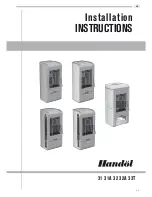
Osburn Matrix Installation and Operation Manual
______________________________________________________________________________ 21
4.4.4
FIRING EACH NEW LOAD HOT
Place the new load of wood on and behind the charcoal and not too close to the glass. Close the
door and open the air control fully. Leave the air control fully open until the firebox is full of
flames, the wood has charred to black and its edges are glowing red. Firing each load of wood hot
accomplishes a few things:
•
drives the surface moisture from the wood,
•
creates a layer of char on the wood, which slows down its release of smoke,
•
heats the firebox components so they reflect heat back to the fire, and
•
heats the flue system so it can produce strong, steady draft for the rest of the cycle.
Although it is important to fire each new load hot to prepare for a clean burn, do not allow the fire
to burn at full intensity for more than a few minutes.
DO NOT LEAVE THE WOOD FIRE UNATTENDED WHILE A NEW LOAD IS BEING FIRED HOT.
When you burn a new load of wood hot to heat up the wood, the wood fire and the flue system,
the result will be a surge of heat from the wood fire. This heat surge is welcome when the room
temperature is a little lower than desirable, but not welcome if the space is already warm.
Therefore, allow each load of wood to burn down so that the space begins to cool off a little
before loading. Letting the space cool before loading is one of the secrets to clean burning and
effective zone heating.
4.4.5
TURNING DOWN THE AIR SUPPLY
Once the firewood, firebox and flue system are hot, you can begin to reduce the air supply for a
steady burn.
As you reduce the air supply to the fire, two important things happen. First, the firing rate slows
down to spread the heat energy in the fuel over a longer period of time. Second, the flow rate of
exhaust through the wood fire and flue slows down, which gives more time for the transfer of heat
from the exhaust. You will notice that as you reduce the air setting, the flames slow down. This is
your indication that the wood fire is burning at its peak efficiency.
If the flames get small and almost disappear when you turn down the air, you have turned down
the air too early, or your firewood is wetter than it should be. With good fuel and correct air
control use, the flames should slow down, but should stay large and steady, even as the air supply
is reduced.
















































